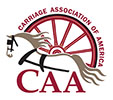This questions was asked as part of a series called “Tack Room Talk” in the March 2003 edition of The Carriage Journal. Three different individuals answered the question.
Answer by Andreas Nemitz of Pahl, Germany.
Andy Nemitz has been awarded all the German driving qualifications, including the top licenses for driving and for FEI driving trainer. He is the owner and operator of “Coaching in Bavaria” and he is a popular speaker at CAA functions. His primary interest lies in coaching and pleasure driving.
A two-wheeled carriage is best to drive if it is well-balanced, i.e., on flat ground the shafts neither press onto the saddle nor do they tend to go upward. In this case a well-built English cart shows its great advantage by the playing of the shafts in the leather loops, it prevents the awful “nodding” of the driver during driving, in contrast to a race horse sulky.
To achieve this, the shafts should run parallel to the ground. As far as I know there exists a list by the late Gordon Cantle with diameters of the wheels (and the lengths of the shafts as well). **For your convenience the list is posted at the end of this article.
If you have already bought a two-wheeler whose shafts do not run parallel to the ground with your horse, there are two remedies:
1) you lower the leather tugs at the saddle (if the width of the shafts do allow this), or 2) you can enlarge the wooden blocks on top of the springs, and you may achieve the parallel alignment again. With original vehicles you may, however, lose the harmony in their overall appearance.
Answer by Katie Whaley (then of Southern Pines, NC).
Katie has been involved in driving her entire life. She is a successful competitor (singles, pairs, four-in-hand, and tandem) in combined driving and pleasure driving, and she is a pleasure driving judge.
I usually go by the height of the dashboard of the carriage; it should be the same height as the rump of the horse or pony.
Answer by Chris Higgins of Framingham, MA.
Chris trained and managed John M. Seabrook’s coaching stable for over twenty years, during which time he successfully showed pairs, tandems, and four-in-hands at Devon and the Royal Winter Fair. Before coming to the United states, he was employed at the Royal Mews, London. Chris is a judge and consultant, and he has been involved with driving horses for more htan 30 years. His interest is in coaching and pleasure driving, as well as combined driving.
When going to buy a carriage, the first thing you need to measure is the distance from where a shaft would attache to the saddle tug on your harness (obviously when on the horse). Put the shafts of the vehicle you are interested in on a stand so that the carriage is level, and measure the distance from where the shafts would attache to the trugs on your harness pad to the ground. If these measurements vary greatly, this carriage will probably be unsuitable for your horse.
However, there are things you can do if the carriage measurements are close to what you need. First, you can adjust the harness tug a hole in either direction without causing much of a change to the vehicle’s weight distribution. Second, if the carriage is a bit too low, you can block up the springs. Unfortunately, if the carriage is too high, its’s difficult to lower it.
The balance of the carriage is also a large consideration because of the potential weight on the horse’s back. Check balance by simply putting people in the carriage and lifting the shafts to the height at which they would be attached to the horse. If you can’t lift the shafts, the weight will be uncomfortable for your horse, and if the opposite is true (if it flies up with not much resistance at all), the shafts will be likely to pull up and cause the belly-band to ride too tight against him.
The point of the shaft should be near the point of the horse’s shoulder, giving him enough room behind to sit in his breeching without touching the carriage. The breeching strap should be attached far enough forward to allow the horse to be able to work properly in the breeching, and should be of a length to accommodate this without being wrapped around the shaft. It is thought that one wrap around the shaft with the breeching strap passing through the dee is stronger than the strap passing once through the dee. This is a matter of opinion, but it should not be passed more than once around, for the simple reason that if you have to get this strap off in a hurry, the binding of the wraps on the saft will greatly hinder this process. Also, if you intend to show, the look of many wraps tells the judge that your harness does not fit this particular vehicle.
The shaft should be long enough to have this necessary room. The width between the shafts should be comfortable for the horse; too narrow will rub the horse, and too wide will disrupt the unity of movement between horse and carriage.
You may also want to give some thought to the height at which you would like to sit behind the horse. If you choose a Meadowbrook-type carriage, you will be lower to the ground and very stable, but without the luxury of being able to see past the horse and down the road, providing you with a somewhat limited view. On the other extreme is the cocking cart, with its extremely high center of gravity, you will have unsurpassed visibility (being at nosebleed altitude), but much less stability. A middle ground is generally preferable.



